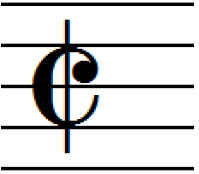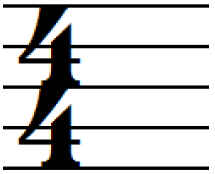THE SINGERS TOOLKIT
An Incomplete Guide for Baffled Choral Singers
Beats
Most music has ACCENTED or LOUDER beats at regular intervals. We normally count the louder beats as 1 and the quieter beats as 2, 3, etc.
With the National Anthem, the counting is ONE two three, ONE two three, etc
GOD save our GRA-cious Queen,
LONG live our NO-ble Queen
GOD save the QUEEN.
In this clip, you will hear the beat underlying the melody. You will notice that some notes are longer than one beat, and some shorter, but the beat itself remains absolutely regular.
Similarly, Good King Wenceslas counts at ONE two three four, ONE two three four, etc.
GOOD King Wen-ces-
LAS looked out
ON the feast of STE-phen.
And here is the sound clip:
On a stave, barlines are placed immediately before the accented beats:


Return to:
TOP
MENU PAGE of Singers Toolkit
MENU PAGE of Organists Online
SimpleTime Signatures
Usually, there is a TIME SIGNATURE (two numbers) at the beginning of the music. The UPPER NUMBER tells you how many beats there in the bar (we will consider the lower number later).
 Sometimes, the time signature will change in the course of a piece.
Sometimes, the time signature will change in the course of a piece.
For the sake of convenience, in FAST music, a conductor may decide to count some beats as part of other beats.
FOUR beats could be counted as TWO
|1 and 2 and |1 and 2 and |
THREE beats could be counted as ONE
|1 and a | 1 and a |
On the other hand, in SLOW music,the beat may be divided into shorter beats.
FOUR
beats may become
|1 and 2 and 3 and 4|
or even
|1, 2, 3, 4, 5, 6 7, 8|
and THREE beats may become
|1 and 2 and 3 and|
or even
|1, 2, 3, 4, 5, 6|
It's important to be quite sure what a conductor intends to do. There have been many disasters, even at professional levels,
when the choir/orchestra has not been absolutely clear how the conductor is going to beat time.
We are now going to consider the LOWER number of the time signature. If you haven't done so already, it would be very useful to have read the page about NOTE VALUES (LINK).
The LOWER NUMBER says what note value is being counted as the beat.
Here are some examples;
A)

There are TWO beats in the bar, counting MINIMS (HALF NOTES) as the beat. Occasionally, this is also represented as
 and may be referred to as CUT C
and may be referred to as CUT C
B)

There are FOUR beats in the bar, counting CROTCHETS (QUARTER NOTES) as the beat. Occasionally, this is also represented as
 and may be referred to as COMMON TIME.
and may be referred to as COMMON TIME.
Return to:
TOP
MENU PAGE of Singers Toolkit
MENU PAGE of Organists Online
Compound
Time Signatures
That was the easy bit. We come now to COMPOUND TIME SIGNATURES. The system of time signatures described above is pretty rigid,
as it depends on notes dividing equally into 1/2s, 1/4s, and 1/8s etc. But for lots of music, the beat naturally divides into THREE equal parts.
As the notation of music evolved across Europe during a period of many centuries, shortcuts and (inconvenient) compromises arose, and that has left us with what is now coming up.
If the UPPER note of a time signature is 6, 9, or 12, you are looking at a compound time signature.
To deduce what is the beat, TIE TOGETHER 3 OF THE NOTES indicated by the LOWER figure and work out what DOTTED note last the same time.
To find the NUMBER of beats, divide the UPPER figure by 3.
For example:
 Divide the upper number by 3 - so the number of beats is 4.
Divide the upper number by 3 - so the number of beats is 4.
The lower number indicates quavers (eighth notes) - tie three together to get a dotted crotchet (quarter note).
The example above has four dotted crotchet (quarter note) beats in a bar.
Here is a clip of a melody with this time signature.
Here is a VIDEO of another melody in 12/8 time. That is,four dotted crotchet beats in a bar, each dividing into three quavers.
Also
 Divide the upper number by 3 - so the number of beats is
2.
Divide the upper number by 3 - so the number of beats is
2.
The lower number indicates minims (half notes) - tie three together to get a dotted semibreve (whole note).
The example above has two dotted semibreve (whole note) beats in a bar.
In this VIDEO the melody is in 6/2. That is, two dotted semibreve beats in a bar, each dividing into three minims.
Return to:
TOP
MENU PAGE of Singers Toolkit
MENU PAGE of Organists Online
Up Beats or Anacruses
Some pieces begin with a short bar - an UP BEAT or ANACRUSIS:

Return to:
TOP
MENU PAGE of Singers Toolkit
MENU PAGE of Organists Online